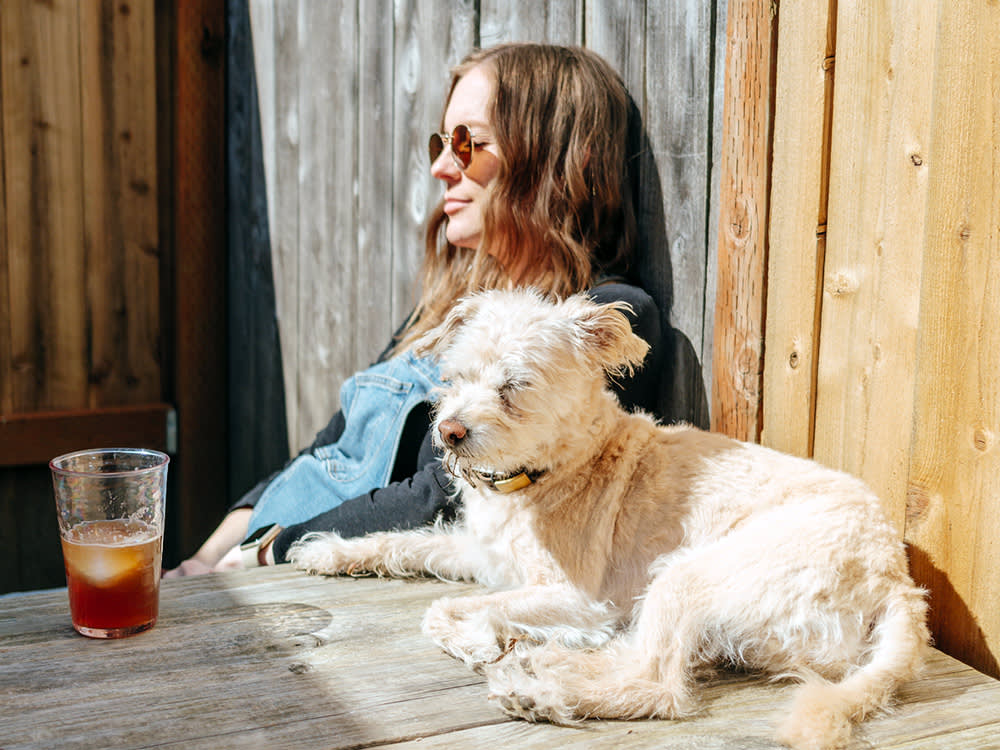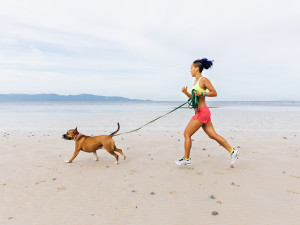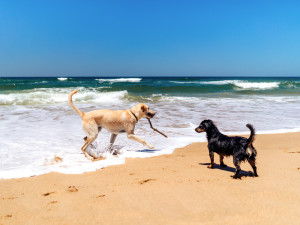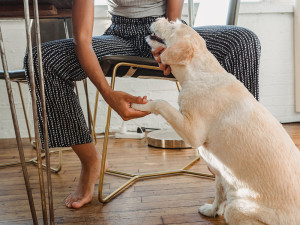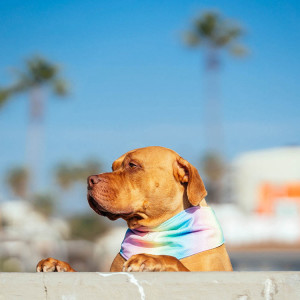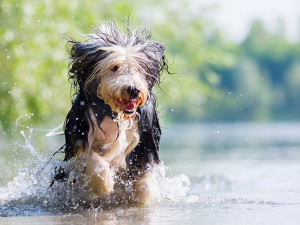Can Dogs Sweat?
Yes, but thankfully nothing like you do after a CrossFit workout.
In This Article:
Do Dogs Have Sweat Glands? Why Dogs Don’t Sweat Like Humans When Dogs Overheat How to Cool Down Your Dog in Hot Weather Breed Condition Differences Frequently Asked Questions
It’s commonly said that dogs only have sweat glands on their paw pads, but that’s not actually true. Unlike humans, who sweat to help with temperature control, dogs sweat from glands all over their body to spread their scent via pheromones.
Do dogs have sweat glands?
Dogs’ bodies are covered in sweat glands. Dogs and humans both have two types of sweat glands:
Merocrine (or eccrine) sweat glands: These are the type of sweat glands that humans are covered in. They help regulate temperature in people, but this effect is minimal in dogs.
Apocrine sweat glands: These glands are like the ones found in human armpits and are used for spreading scent.
Dogs have merocrine sweat glands only in their nasal planum (the hairless part of their nose) and foot pads. They also have apocrine sweat glands over all the hairy parts of their bodies. These glands secrete a liquid that contributes to a dog’s scent. It’s best not to think of your dog’s skin as a giant armpit, though. Their pheromones are made to signal other dogs, so dog parents can’t pick up on most of them. They experience the world through smell, so it’s not surprising they’re coated in scent glands.
How much do you spend on your pet per year?
Why dogs don’t sweat like humans
So, do dogs sweat? Sure, but not in the same way that humans do. Dogs constantly secrete fluid from their sweat glands to maintain their scent. This goes unnoticed most of the time because the sweat is spread throughout their coat. Some hairless breeds may have more obvious sweating because there’s nowhere for the sweat to spread.
Dogs with skin allergies can experience excessive sweating as well. This condition, called hyperhidrosis, can lead to damp spots on their bodies or a greasier appearance to their coat. Treating the cause of the allergies can help keep this type of sweating under control and help prevent secondary problems like skin infections.
Does sweating like this help dogs stay cool? Not really. To understand how they stay cool it’s helpful to review a few major ways that animals can regulate their temperature:
Ambient heating and cooling: This works well for cold-blooded animals, like reptiles and amphibians, who can function in a wide range of body temperatures. This isn’t effective for mammals like dogs and humans, because they need to keep their body temperature in a very narrow range to survive.
Sweating: Some mammals cool themselves effectively by using the surface of their skin to dissipate heat. They have a large network of blood vessels near the surface of their skin so that blood from the muscles (which produce heat through their activity) can be cooled. Sweating helps this process through evaporation.
Panting: Some animals rely on evaporation from their respiratory system to keep cool. They can greatly increase the amount of air passing through their mouth and dilate the blood vessels in their tongue to maximize the surface area for cooling.
Animals like dogs and birds don’t rely on sweating to keep themselves cool because of the reduced effectiveness of evaporation due to their thick coats (or feathers). A dog’s coat can actually act as a buffer to insulate them from temperature extremes. This insulating function is lost when their coat gets wet. Dogs will sweat some from their paw pads and nose when they’re hot, but these surfaces are so small that they don’t significantly affect heat loss. Instead of sweating, dogs pant to get rid of heat.
Why are my dog’s paws sweaty?
Even though sweating doesn’t play a big role in getting rid of heat, dogs will still get sweaty paws when they’re hot. Young puppies (one to three months old) may sweat spontaneously from their paw pads, but this seems to lessen as they age. Dogs can get sweaty paw pads due to adrenaline release if they’re stressed or fearful. Nausea may also cause sweaty paw pads, though this is not well documented.
Although alterations in sweating patterns are documented in diabetic humans, these changes have not been reported in dogs. It’s possible that dogs could suffer some of the same effects, which go unnoticed due to their smaller number of merocrine sweat glands. If your diabetic dog is sweating while sleeping, it could be related to low blood sugar levels, which can also cause adrenaline release. See your veterinarian if you feel your diabetic dog is sweating abnormally.
When dogs overheat
Dogs can overheat due to external heat or overexertion. Overheating in dogs is a serious issue, and it can lead to heatstroke, which can be deadly. Some environmental conditions that can make it more likely for a dog to overheat include:
Hot weather
Enclosure in a small space (like a parked car)
High humidity
Poor ventilation
Breed and condition differences
Some breed-related and medical conditions can also make dogs more predisposed to heat injury. Some common concerns include:
Brachycephalic (flat-faced) breeds
Dark-coated breeds
Dehydration
Obesity
Heart disease
Laryngeal paralysis
Collapsing trachea
Dogs overheat when they can’t dissipate enough heat through panting to keep up with the amount of heat they’re generating from exertion or being exposed to in the environment. Overheating dogs will pant heavily, drool, become lethargic or weak, and/or collapse. With extreme overheating, they can develop vomiting, diarrhea, bruising, spontaneous bleeding, and seizures.
How to cool down your dog in hot weather
The best way to keep your dog cool in hot weather is to be proactive. Avoid long walks and significant activity during the hottest parts of the day. Increase your dog’s activity level gradually, especially as the weather gets warmer.
One of the most common times for dogs to experience heatstroke is on the first nice day of the year. Dogs that spent the winter being couch potatoes are suddenly asked to go for a long run with their parents on the first warm day of spring, and their bodies can’t keep up with the sudden change in demand.
It’s important to know how to cool your dog down after a walk, or even during a walk if they’re showing any signs of distress. Stop and assess if your dog is showing any of these signs:
Continued panting despite resting
Excessive drooling
Lethargy or weakness
If you’re worried your dog is overheated, you can take their temperature if you have a thermometer handy. A dog’s normal temperature is 101 degrees Fahrenheit to 102.5 degrees Fahrenheit (38.3 degrees Celsius to 39.2 degrees Celsius). Temperatures over 104 degrees Fahrenheit (40 degrees Celsius) are concerning and should be reported to a veterinarian immediately.
Some strategies to help your dog begin to cool off include:
Getting out of the heat (indoors or into shade)
Providing water
Misting with cool or room temperature (not cold!) water
Placing in front of a fan
It’s important not to use ice packs or put your dog in an ice bath to cool them. This dramatic temperature shift can prevent them from returning to a normal temperature, cause further injury, or worsen their condition. It’s best to see a veterinarian as soon as possible if you’re concerned your dog has overheated. Depending on how hot they get, dogs with heat injury can have serious issues and may even become hypothermic after cooling.
Although heatstroke is scary, you can prevent it by being conscious of the weather, your dog’s activity level, their conditioning, and any health issues. Dogs aren’t great at slowing down when they’re having fun, so it’s up to you to be aware of how the heat can affect them. Always err on the side of frequent breaks and plenty of hydration.
FAQs (People also ask):
How long can a dog run safely?
A dog’s tolerance for running will depend on their conditioning, the temperature, and the humidity level. Dogs need to be worked up to any activity gradually, and pet parents need to be aware of the signs of problems to watch for.
Does hyperglycemia in dogs cause sweating?
Dogs with diabetes may become hyperglycemic (have high blood sugar) during the day, depending on how well their insulin is controlled. There is not a known association between high blood sugar and sweating in dogs.
How can I keep my dog cool on hot summer days?
The best ways to keep your dog cool during hot summer days are to provide adequate hydration, give frequent opportunities for rest while outside, stay in the shade, and limit activity during the hottest part of the day.
References:
Functional Activity of the Eccrine Sweat Glands in the Toe-pads of the Dogopens in new tab
Metastatic Apocrine Sweat Gland Adenocarcinoma in a Terrier Dogopens in new tab
Apocrine Sweat Glands in the Circumanal Glands of the Dogopens in new tab
Pathophysiology and Pathological Findings of Heatstroke in Dogsopens in new tab
Pathophysiology of Heatstroke in Dogs – Revisitedopens in new tab
Hyperhidrosis in Naïve Purpose-Bred Beagle Dogs (Canis familiaris)opens in new tab
